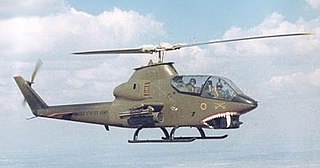
The Bell AH-1 Cobra is a single-engined attack helicopter developed and manufactured by the American rotorcraft manufacturer Bell Helicopter. A member of the prolific Huey family, the AH-1 is also referred to as the HueyCobra or Snake.

The Boeing AH-64 Apache is an American twin-turboshaft attack helicopter with a tailwheel-type landing gear arrangement and a tandem cockpit for a crew of two. It features a nose-mounted sensor suite for target acquisition and night vision systems. It is armed with a 30 mm (1.18 in) M230 chain gun carried between the main landing gear, under the aircraft's forward fuselage, and four hardpoints mounted on stub-wing pylons for carrying armament and stores, typically a mixture of AGM-114 Hellfire missiles and Hydra 70 rocket pods. The AH-64 has significant systems redundancy to improve combat survivability.
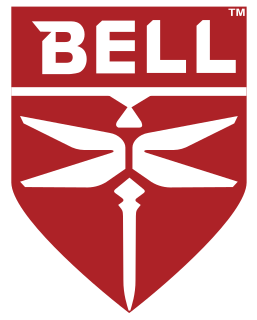
Bell Textron Inc. is an American aerospace manufacturer headquartered in Fort Worth, Texas. A subsidiary of Textron, Bell manufactures military rotorcraft at facilities in Fort Worth, and Amarillo, Texas, as well as commercial helicopters in Mirabel, Quebec, Canada.

An attack helicopter is an armed helicopter with the primary role of an attack aircraft, with the offensive capability of engaging ground targets such as enemy infantry, military vehicles and fortifications. Due to their heavy armament they are sometimes called helicopter gunships.

The Bell AH-1 SuperCobra is a twin-engined attack helicopter based on the United States Army's single-engine AH-1 Cobra. The twin Cobra family, itself part of the larger Huey family, includes the AH-1J SeaCobra, the AH-1T Improved SeaCobra, and the AH-1W SuperCobra. The AH-1W was the backbone of the United States Marine Corps's attack helicopter fleet for decades until it was replaced by the next generation Bell AH-1Z Viper.

The AgustaWestland Apache is a licence-built version of the Boeing AH-64D Apache Longbow attack helicopter for the British Army Air Corps. The first eight helicopters were built by Boeing; the remaining 59 were assembled by Westland Helicopters at Yeovil, Somerset in England from Boeing-supplied kits. Changes from the AH-64D include Rolls-Royce Turbomeca RTM322 engines, a new electronic defensive aids suite and a folding blade mechanism allowing the British version to operate from ships. The helicopter was initially designated WAH-64 by Westland Helicopters and was later given the designation Apache AH Mk 1 by the Ministry of Defence.

Hughes Helicopters was a major manufacturer of military and civil helicopters from the 1950s to the 1980s.
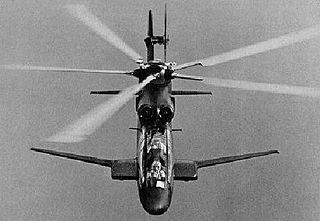
The Sikorsky S-67 Blackhawk was a private-venture, prototype attack helicopter built in 1970 with Sikorsky Aircraft research and development (R&D) funds. A tandem, two-seat aircraft designed around the dynamic drive and rotor systems of the Sikorsky S-61, it was designed to serve as an attack helicopter or to transport up to eight troops into combat.
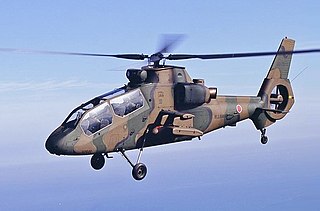
The Kawasaki OH-1 is a military scout/observation helicopter developed and manufactured by the Kawasaki Aerospace Company. The primary operator is the Japan Ground Self-Defense Force (JGSDF), who originally procured the OH-1 as a domestically produced successor to their existing OH-6D Loach fleet. The OH-1 has the distinction of being the first helicopter to be entirely produced in Japan.

The Lockheed AH-56 Cheyenne was an attack helicopter developed by Lockheed for the United States Army. It rose from the Army's Advanced Aerial Fire Support System (AAFSS) program to field the service's first dedicated attack helicopter. Lockheed designed the Cheyenne using a four-blade rigid-rotor system and configured the aircraft as a compound helicopter with low-mounted wings and a tail-mounted thrusting propeller driven by a General Electric T64 turboshaft engine. The Cheyenne was to have a high-speed dash capability to provide armed escort for the Army's transport helicopters, such as the Bell UH-1 Iroquois.
MD Helicopters, Inc. is an American aerospace manufacturer. It produces light utility helicopters for commercial and military use. The company was a subsidiary of Hughes Aircraft until 1984, when McDonnell Douglas acquired it and renamed it McDonnell Douglas Helicopter Systems. It later became MD Helicopters in the late 1990s when McDonnell Douglas merged with Boeing.

The Boeing Vertol YUH-61 was a twin turbine-engined, medium-lift, military assault/utility helicopter. The YUH-61 was the runner-up in the United States Army Utility Tactical Transport Aircraft System (UTTAS) competition in the early 1970s to replace the Bell UH-1 Iroquois helicopter. At the end of the flyoff program, Sikorsky Aircraft was awarded a contract to develop and build its UH-60A entry.

The Bell Model 309 KingCobra was an experimental attack helicopter developed by Bell Helicopter, based on the Bell AH-1 Cobra.
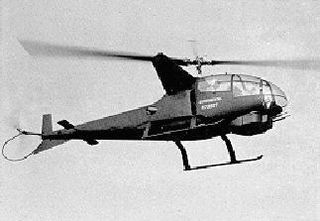
The Bell 207 Sioux Scout was a modified Bell 47 helicopter, developed by Bell Helicopter under contract from the United States Army, as a proof-of-concept demonstrator for the Bell D-255 helicopter gunship design, featuring a tandem cockpit, stub wings, and a chin-mounted gun turret.

The Bell AH-1Z Viper is a twin-engine attack helicopter, based on the AH-1W SuperCobra, designed and produced by the American aerospace manufacturer Bell Helicopter. Being one of the latest members of the prolific Bell Huey family, it is also called "Zulu Cobra", based on the military phonetic alphabet pronunciation of its variant letter.
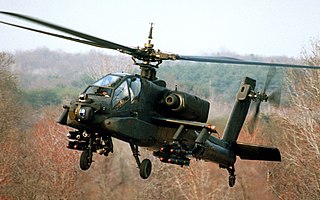
The Advanced Attack Helicopter (AAH) was a United States Army program to develop an advanced ground attack helicopter beginning in 1972. The Advanced Attack Helicopter program followed cancellation of the Lockheed AH-56 Cheyenne. After evaluating industry proposals, the AAH competition was reduced to offerings from Bell and Hughes. Following a flight test evaluation of prototypes, Hughes' YAH-64 was selected in December 1976.

The United States Army Aviation Museum is an aviation museum located on Fort Rucker near Daleville, Alabama. It has the largest collection of helicopters held by a museum in the world. The museum features some 50 aircraft on public display with aviation artifacts ranging from a replica of the Wright brothers' Model B military biplane to an AH-64 Apache from Operation Desert Storm. The museum has over 160 aircraft in its collection and holds 3,000 historical items.

The Bell Huey family of helicopters includes a wide range of civil and military aircraft produced since 1956 by Bell Helicopter. This H-1 family of aircraft includes the utility UH-1 Iroquois and the derivative AH-1 Cobra attack helicopter series and ranges from the XH-40 prototype, first flown in October 1956 to the 21st-century UH-1Y Venom and AH-1Z Viper.

The Sikorsky S-97 Raider is a high-speed scout and attack compound helicopter based on the Advancing Blade Concept (ABC) with a coaxial rotor system under development by Sikorsky Aircraft. Sikorsky planned to offer it for the United States Army's Armed Aerial Scout program, along with other possible uses. The S-97 made its maiden flight on 22 May 2015.
The Future Attack Reconnaissance Aircraft (FARA) program was initiated by the United States Army in 2018 to develop a successor to the Bell OH-58 Kiowa scout helicopter as part of the Future Vertical Lift program. The OH-58 was retired in 2014; three prior programs for a successor were cancelled prior to reaching production: Light Helicopter Experimental, Armed Reconnaissance Helicopter, and Armed Aerial Scout.


















